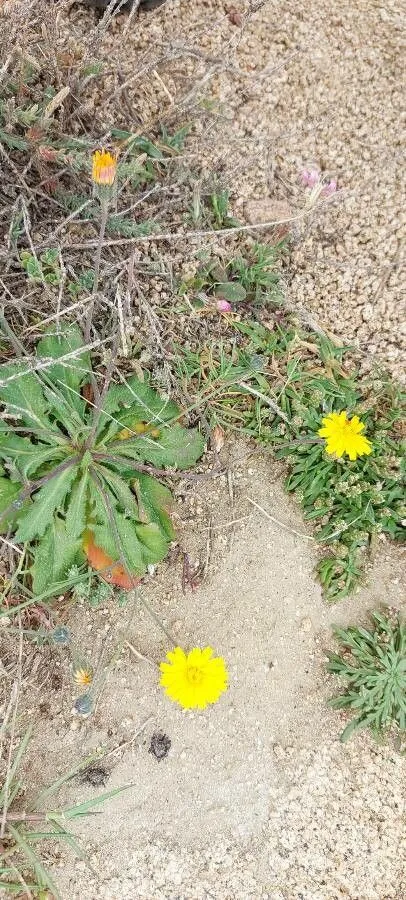
Author: (L.) Bornm.
Bibliography: Mitth. Thüring. Bot. Vereins 30: 79 (1913)
Year: 1913
Status: accepted
Rank: species
Genus: Crepis
Vegetable: False
Observations: Europe to Medit. and Iran, Arabian Pen.
Hawk’s-beard, known scientifically as Crepis sancta, is a plant belonging to the Asteraceae family. This species exhibits a remarkable adaptability, flourishing in various regions ranging from Europe down to the Mediterranean and extending as far as Iran and the Arabian Peninsula.
Botanist J. F. Bornmüller, commonly referenced as Bornm., formally described Crepis sancta in 1913, as noted in the Mitteilungen aus dem Thüringischen Botanischen Vereins, Volume 30, page 79. This introduction into scientific literature has allowed subsequent researchers to study and document the characteristics and distribution of this resilient plant.
Hawk’s-beard is characterized by its easily recognizable yellow flowers, which are typical of many members of the Asteraceae family. These blooms often appear on erect stems with a rosette of leaves at their base, a growth form that helps the plant thrive in various environments. The plant’s ability to adapt to a wide range of climates—from the temperate zones of Europe to the arid regions of the Arabian Peninsula—makes it a fascinating subject for both botanists and ecologists.
In its habitats, Crepis sancta plays a significant role in the ecosystem, providing nectar for pollinators such as bees and butterflies. Its structural form also offers some shelter to smaller insects, contributing to the biodiversity of its environment. This species’ widespread availability and adaptability also make it an ideal candidate for studies on plant resilience and adaptability, offering insights into how plants can survive and proliferate across different and often challenging climates.
The study and understanding of Hawk’s-beard not only deepen our knowledge of plant biodiversity but also highlight the importance of conservation efforts for wild plant species that enrich our natural world.
Fra: crépide de nîmes, crépide sainte
Deu: hasensalat, heiliger pippau
Eng: hawk’s-beard
Swe: helgonfibbla
Tur: hindiba
Ita: radicchiella di terrasanta
Sqi: shmangë e shenjtë
Rus: скерда палестинская
Bul: четинеста дрипавка
Hye: զամբյուղախոտ պաղեստինյան
Heb: נִיסָנִית דּוּ-קַרְנִית, ניסנית דו-קרנית
Ara: سَراغَة مُقَدَّسَة
En: Hawk’s-beard
Sq: Shmangë e shenjtë
Ar: حلاوه (حَلاوه)، حلاوى (حَلاوى)، هيثان, حودان، حوذان (حَوَذان), سَراغَة مُقَدَّسَة
Hy: Զամբյուղախոտ պաղեստինյան
Bg: Четинеста дрипавка
Fi: Välimerenkeltto
Fr: Crépide de Nîmes, Crépide sainte
De: Hasensalat, Heiliger Pippau
He: נִיסָנִית דּוּ-קַרְנִית, ניסנית דו-קרנית
It: Radicchiella della terra santa, Radicchiella di Terrasanta
Ru: Скерда палестинская
Sv: Helgonfibbla
Tr: Hindiba
Taken Mar 13, 2018 by Mehmet Basbag (cc-by-sa)
Taken Mar 25, 2022 by Enes Ünyılmaz (cc-by-sa)
Taken Apr 12, 2018 by jose (cc-by-sa)
Taken Apr 12, 2018 by jose (cc-by-sa)
Taken Feb 16, 2021 by Sagredo Mónica (cc-by-sa)
Taken Apr 14, 2022 by Sergio costantini (cc-by-sa)
Taken Mar 13, 2022 by Rafael Sanchez (cc-by-sa)
Taken Feb 21, 2017 by Llandrich anna (cc-by-sa)
Taken Jan 4, 2022 by Fabrice Rubio (cc-by-sa)
Taken Mar 19, 2021 by Daniel Bourget (cc-by-sa)
Taken Mar 14, 2019 by Thibaut Suisse (cc-by-sa)
Taken Feb 28, 2021 by Johanna Charrier (cc-by-sa)
Taken Feb 7, 2022 by Nanni Matteo (cc-by-sa)
Taken Feb 7, 2022 by Nanni Matteo (cc-by-sa)
Taken Feb 7, 2022 by Nanni Matteo (cc-by-sa)
Taken Mar 13, 2020 by Pierre Bonnet (cc-by-sa)
Taken May 8, 2017 by Yoan MARTIN (cc-by-sa)
Taken May 8, 2017 by Yoan MARTIN (cc-by-sa)
Taken Feb 21, 2017 by Llandrich anna (cc-by-sa)
Taken May 8, 2017 by Yoan MARTIN (cc-by-sa)
Taken May 8, 2017 by Yoan MARTIN (cc-by-sa)
Taken May 8, 2017 by Yoan MARTIN (cc-by-sa)
Taken Apr 13, 2022 by Anna G (cc-by-sa)
Taken Apr 10, 2017 by Hélène Launay (cc-by-sa)
Taken May 4, 2020 by Lefteris (cc-by-sa)
Taken May 4, 2020 by Lefteris (cc-by-sa)
Taken Mar 8, 2021 by Antonio Barba Herrers (cc-by-sa)
Taken May 4, 2020 by Lefteris (cc-by-sa)
Taken Apr 22, 2013 by Tela Botanica − Marie PORTAS (cc-by-sa)
© copyright of the Board of Trustees of the Royal Botanic Gardens, Kew.
© copyright of the Board of Trustees of the Royal Botanic Gardens, Kew.
© copyright of the Board of Trustees of the Royal Botanic Gardens, Kew.
Bloom months: [‘mar’, ‘apr’, ‘may’]
Family: Myrtaceae Author: (F.Muell.) K.D.Hill & L.A.S.Johnson Bibliography: Telopea 6: 402 (1995) Year: 1995 Status:…
Family: Rubiaceae Author: Pierre ex A.Froehner Bibliography: Notizbl. Bot. Gart. Berlin-Dahlem 1: 237 (1897) Year:…
Family: Sapindaceae Author: Koidz. Bibliography: J. Coll. Sci. Imp. Univ. Tokyo 32(1): 38 (1911) Year:…
Family: Asteraceae Author: A.Gray Bibliography: Pacif. Railr. Rep.: 107 (1857) Year: 1857 Status: accepted Rank:…
Family: Fabaceae Author: Medik. Bibliography: Vorles. Churpfälz. Phys.-Ökon. Ges. 2: 398 (1787) Year: 1787 Status:…
Family: Aspleniaceae Author: (Cav.) Alston Bibliography: Bull. Misc. Inform. Kew 1932: 309 (1932) Year: 1932…